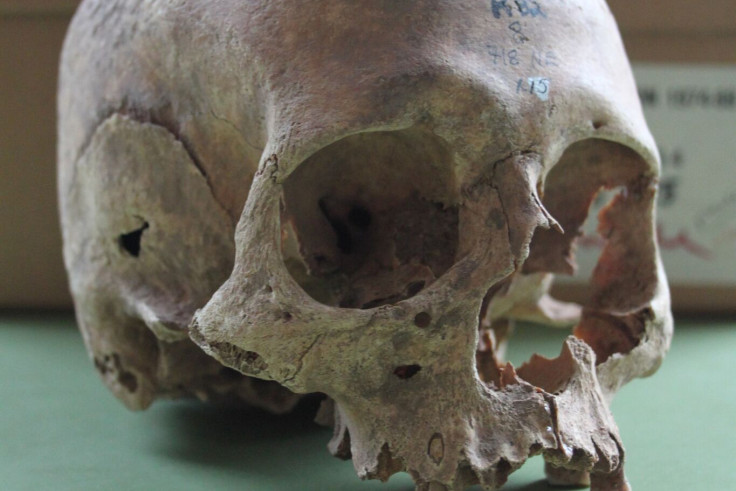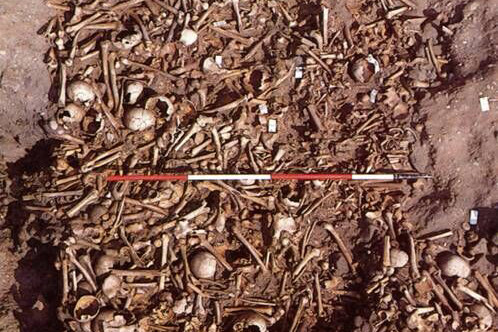Midlands mass grave was burial site for Viking 'Great Heathen Army' war dead, new study reveals
The powerful Norse army was sent to invade the four Anglo-Saxon kingdoms that constituted England in 865 AD.

In the 70s, a mysterious mass grave complex, containing the remains of hundreds of people, was unearthed by archaeologists in Repton, Derbyshire. The initial signs indicated that the burial site was associated with a Viking army, however, radiocarbon dating seemed to pour cold water on this hypothesis, suggesting that the bones had actually been left there over several centuries.
Now, new research has revealed that, in fact, the remains are consistent with a date in the 9<sup>th century. Based on these findings, Cat Jarman and colleagues from the University of Bristol's Department of Anthropology and Archaeology suggest that the mass grave was a burial site for the war dead of the Viking Great Army.
This military force – known by the Anglo-Saxons as the Great Heathen Army – was a powerful coalition of Norse warriors mainly originating from Denmark, although some came from Sweden and Norway, who banded together under a unified command to invade the four Anglo-Saxon kingdoms that constituted England in 865 AD.
Historical records indicate that this army spent the winter at Repton in 873 AD, driving the king of Mercia – one of the Anglo-Saxon kingdoms, centred on the midlands – into exile in the process.
The initial excavations, which took place throughout the 70s and 80s, uncovered several Viking graves and a vault containing the bodies of nearly 300 people beneath a shallow mound in the vicarage garden of St. Wystan's Church in Repton.
The complex also contains the remains of an Anglo-Saxon building which was partially torn down and turned into a Viking burial chamber. One room in this chamber was filled to the brim with the remains of at least 264 people.
The majority were men aged between 18 and 45 - with many showing signs of violent injury - although around 20% of the bodies were female (there is some evidence to suggest that Viking armies sometimes included female warriors).
Archaeologists found numerous artefacts among the bones, including weapons and silver pennies dating to the period 872-875 AD.
All the signs pointed to the site once belonging to the Viking Great Army, however the initial radiocarbon dating indicated that the bones came from very different periods, meaning they could not all have originated from the Viking Age. But the latest dating attempts showed more consistent results.
"The previous radiocarbon dates from this site were all affected by something called marine reservoir effects, which is what made them seem too old," said Jarman.
"When we eat fish or other marine foods, we incorporate carbon into our bones that is much older than in terrestrial foods. This confuses radiocarbon dates from archaeological bone material and we need to correct for it by estimating how much seafood each individual ate."

One particularly notable grave from the site, dated to 873-886, contains two men, one of whom was buried with a Thor's hammer pendant, a Viking sword, and several other artefacts.
It appears that this warrior received numerous fatal injuries just before his death. Intriguingly, a boar's tusk was placed between his legs, perhaps suggesting that one particularly bad injury to his femur may have severed his genitals. Researchers think that the tusk was placed there to compensate for this loss in the after-life.
Another extraordinary grave outside the mound - containing four juveniles aged between eight and 18 with signs of traumatic injury - may have been a ritual grave, according to researchers, mirroring historical Viking accounts which talk of sacrificial killings associated with burial sites.
"The date of the Repton charnel bones is important because we know very little about the first Viking raiders that went on to become part of considerable Scandinavian settlement of England," Jarman added.
"Although these new radiocarbon dates don't prove that these were Viking army members it now seems very likely. It also shows how new techniques can be used to reassess and finally solve centuries old mysteries."
The Vikings had conducted 'hit-and-run' raids across the British Isles since the late 8<sup>th century, however, these were generally localised and limited to small centres of wealth. But by the mid-9<sup>th century, Viking objectives had shifted and the Great Army – which was by all accounts one of the largest forces of its kind - was set up to conquer Britain.
Its campaign against the Anglo-Saxon kingdoms lasted 14 years, culminating in the defeat of three of the kingdoms, leaving only Wessex unconquered. Alfred the Great, the King of Wessex, finally defeated the Vikings in 878 at the Battle of Edington and a treaty was agreed whereby the Norsemen were able to retain control in much of northern and eastern England, while Wessex in the south and west remained under Anglo-Saxon influence.
These areas under Viking control became known as the Danelaw although Norse power gradually diminished over the next century as Wessex solidified its hold on England.
The new findings are published in the journal Antiquity.





















